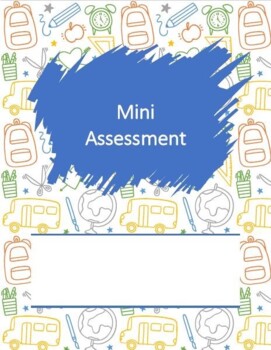COMPLETE 3rd Grade Math Assessment BUNDLE
N-Menn-Ed's Store
48 Followers
Grade Levels
2nd - 4th
Subjects
Resource Type
Standards
CCSS3.MD.A.1
CCSS3.MD.A.2
CCSS3.MD.B.3
CCSS3.MD.B.4
CCSS3.MD.C.5
Formats Included
- Zip
N-Menn-Ed's Store
48 Followers
Products in this Bundle (23)
showing 1-5 of 23 products
Description
These assessments are aligned to the Florida Math Standards (MAFS), Common Core Standards (CCSS), and to the Florida Standards Assessment (FSA) question types (multiple-choice, multi-select, table match items, gridded response, & editing task items).
10 - 20% of questions at a Depth of Knowledge (DOK) level 1
60 - 80% of questions at a DOK 2
10 -20% of questions at a DOK 3
This assessment is a wonderful way to assess the standard and see how your scholars do with the various question types and different DOK levels. You can also plan with the end in mind by referencing these as you plan!
Total Pages
Answer Key
Included
Teaching Duration
N/A
Report this resource to TPT
Reported resources will be reviewed by our team. Report this resource to let us know if this resource violates TPT’s content guidelines.
Standards
to see state-specific standards (only available in the US).
CCSS3.MD.A.1
Tell and write time to the nearest minute and measure time intervals in minutes. Solve word problems involving addition and subtraction of time intervals in minutes, e.g., by representing the problem on a number line diagram.
CCSS3.MD.A.2
Measure and estimate liquid volumes and masses of objects using standard units of grams (g), kilograms (kg), and liters (l). Add, subtract, multiply, or divide to solve one-step word problems involving masses or volumes that are given in the same units, e.g., by using drawings (such as a beaker with a measurement scale) to represent the problem.
CCSS3.MD.B.3
Draw a scaled picture graph and a scaled bar graph to represent a data set with several categories. Solve one- and two-step “how many more” and “how many less” problems using information presented in scaled bar graphs. For example, draw a bar graph in which each square in the bar graph might represent 5 pets.
CCSS3.MD.B.4
Generate measurement data by measuring lengths using rulers marked with halves and fourths of an inch. Show the data by making a line plot, where the horizontal scale is marked off in appropriate units-whole numbers, halves, or quarters.
CCSS3.MD.C.5
Recognize area as an attribute of plane figures and understand concepts of area measurement.


